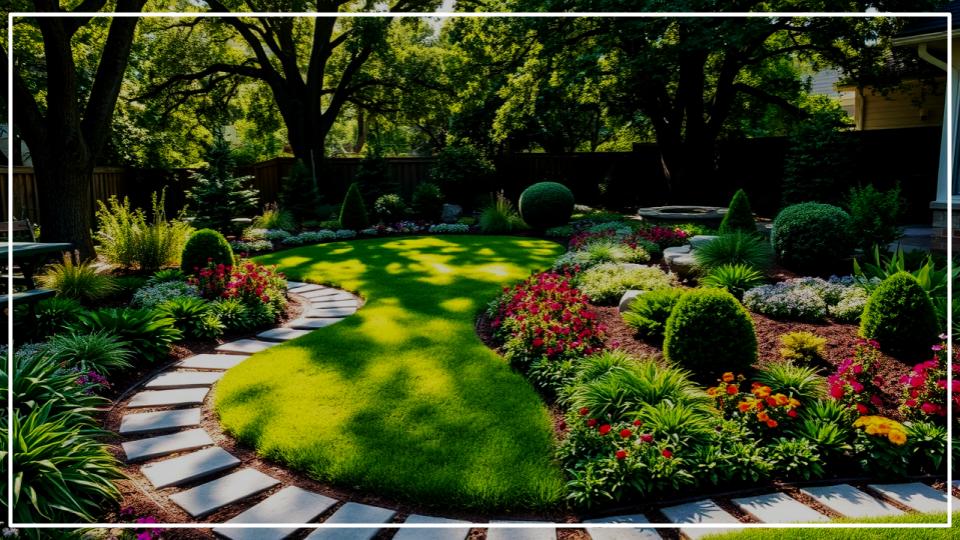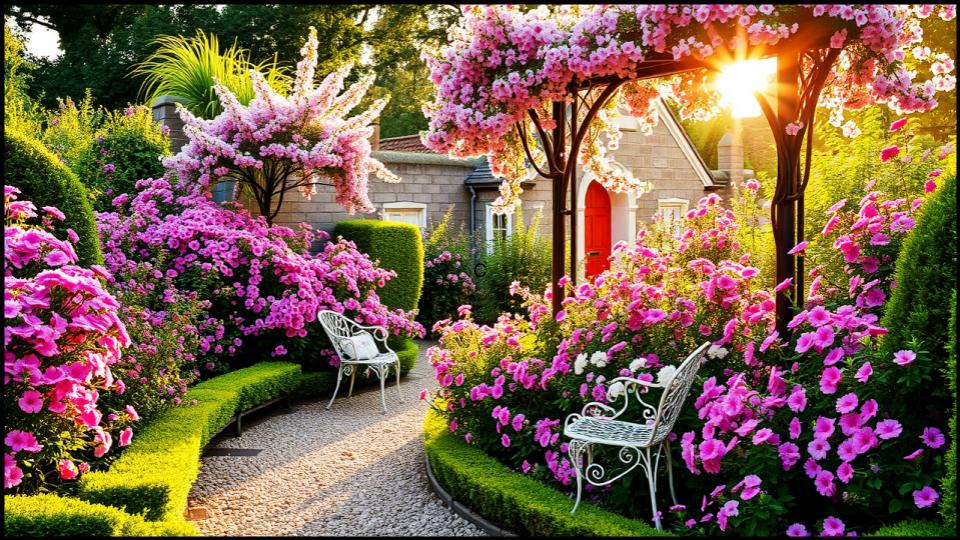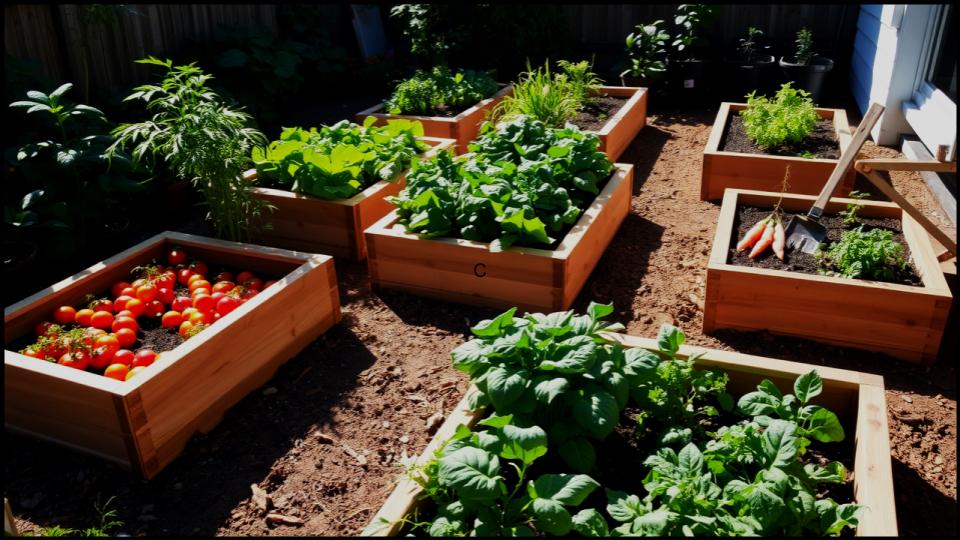
A garden is so much more than just a collection of plants; it’s a living extension of your home, a sanctuary for the senses, and a canvas for personal expression. But staring at a blank patch of lawn or a tired, overgrown space can feel overwhelming. Where do you even begin? The secret to a truly spectacular backyard transformation lies in a thoughtful plan. These garden layout ideas are the architectural bones of your outdoor space, turning a simple yard into a purposeful and breathtaking retreat.
In this guide, we’ll walk through distinct layouts, moving from foundational styles to clever solutions for every type of space. You’ll find the inspiration and practical advice you need to design a garden that not only looks beautiful but also perfectly suits your lifestyle. Let’s start creating the garden you’ve always dreamed of.
Key Takeaways for a Beautiful Garden Layout
Here are the core principles for designing a garden you’ll love:
- Define Your Purpose: Decide if your garden is for relaxing, entertaining, growing food, or attracting wildlife. Function should always guide form.
- Create Focal Points: Use a special tree, a bench, a birdbath, or a stunning container to draw the eye and create a sense of order.
- Think in Layers: Plant from back to front, placing taller plants like shrubs and grasses behind mid-sized perennials, with low-growing groundcovers and annuals at the front.
- Embrace the Curve: Gently curving paths and bed lines can make a space feel larger and more natural than straight, rigid lines.
1. Foundational Garden Styles
Every great garden starts with a core concept. These classic styles provide a framework you can adapt to your personal taste and your property’s unique character.
The Classic Formal Garden
Defined by symmetry, clean lines, and geometric shapes—think squares, rectangles, and circles—the formal garden exudes elegance and order. Hedges of boxwood or yew are often used to create crisp outlines for flower beds or define walkways. A central focal point, like a fountain, urn, or sculpture, is essential to anchor the design. In my own garden, I’ve found that even a small formal herb garden with a central birdbath can bring a powerful sense of calm and intention to the landscape.
The Informal Cottage Garden
If you dream of a romantic, overflowing garden, this style is for you. The cottage garden is characterized by a dense mix of ornamental and edible plants, from billowing roses and delphiniums to herbs and lettuces tucked in wherever they fit. The layout is relaxed, with winding paths and a charming sense of self-sown abundance. The key is controlled chaos; use a loose color palette and repeat plant forms to keep it from looking messy.

The Modern Minimalist Garden
For a contemporary and low-fuss landscape design, embrace minimalism. This style focuses on strong architectural lines, a limited plant palette, and the beauty of natural materials like concrete, steel, and gravel. Plantings are often done in bold, graphic masses—think a row of ornamental grasses or a grid of identical succulents. According to experts at the University of Minnesota Extension, effective minimalist design relies on the dramatic use of foliage texture and form rather than a riot of floral color.
2. Layouts for Living and Growing
A garden should be a productive and usable space. These layouts integrate function directly into the design, enriching your life and your table.
The Potager (Kitchen Garden)
Why separate your edibles and your ornamentals? The French potager intermingles vegetables, herbs, and flowers in a layout that is as beautiful as it is productive. Arrange your beds in a geometric pattern, perhaps around a central path or feature, and use edible flowers like nasturtiums or pansies to line the beds. This is one of my favorite garden layout ideas because it brings the joy of harvesting right to your doorstep.
The Dedicated Cutting Garden
For those who love fresh bouquets, a cutting garden is a must. This layout is pure function: arrange plants in rows, much like a vegetable garden, to make tending and harvesting easy. Choose flowers with long, sturdy stems that hold up well in a vase. A common mistake I see is gardeners trying to cut heavily from their main display beds, leaving them with unsightly gaps. A separate cutting garden solves this problem entirely.
The Outdoor Living Room
Integrate your garden with your daily life by designing an “outdoor room.” Use a deck, patio, or even a simple patch of level gravel as your “floor.” Define the space with large containers, a trellis wall for privacy, or a border of fragrant plants like lavender or jasmine. Comfortable seating is non-negotiable! This approach effectively extends your living area and makes the garden an irresistible destination.
The Pollinator Paradise
Design a garden specifically to support bees, butterflies, and hummingbirds. This layout involves planting in large, layered drifts of color that pollinators can easily spot. According to the Xerces Society for Invertebrate Conservation, it’s crucial to provide blooms across three seasons—spring, summer, and fall—to offer a continuous food source. Include host plants, like milkweed for monarch butterflies, to create a complete habitat.
3. Creative Structures & Path-Based Layouts
Use hardscaping and clever planting techniques to add dimension, create intrigue, and solve common garden challenges.
The Winding Path Garden
Create a sense of journey and mystery, even in a small yard, with a meandering path. A curved walkway naturally slows the pace and encourages exploration, revealing different views of the garden as you move through it. Let plants spill over the edges to soften the lines. This is a fantastic strategy for small garden design, as it makes the space feel larger than it is.
The Vertical Garden
When you run out of ground, look up! Use trellises, arbors, wall-mounted planters, and pergolas to grow vines, cascading plants, and even vegetables. Vertical gardening adds a dramatic architectural element and is a perfect solution for narrow side yards, balconies, and urban spaces.
The Raised Bed Revolution
Raised beds offer unparalleled control over your soil and are a gift to your back. Arrange them in a symmetrical grid for a clean, organized look, or stagger them for a more informal feel. You can build them from wood, stone, or metal to match your garden’s aesthetic. My go-to material is cedar because of its natural resistance to rot.

The Deep, Layered Border
The most visually stunning garden beds use layers. Place your tallest plants (shrubs, tall grasses) at the back, your medium-height perennials and annuals in the middle, and your shortest plants and groundcovers at the front edge. This simple principle of landscape design creates a lush, full look and ensures every plant is visible.
4. Layouts for Special Conditions & Themes
Every yard has its challenges and unique opportunities. These ideas help you make the most of what you have.
The Serene Shady Retreat
Don’t curse your shady spots; celebrate them! Design a tranquil retreat using shade-loving plants known for their beautiful foliage, like hostas, ferns, heucheras, and Japanese forest grass. Combine different textures and shades of green to create a cool, calming atmosphere. A simple bench or a quiet water feature can complete the serene picture.
The Gravel & Rock Garden
For hot, dry areas or a low-maintenance backyard transformation, consider a gravel or rock garden. This style, also known as xeriscaping, uses gravel as a mulch and features drought-tolerant plants like succulents, sedums, and Mediterranean herbs. It’s a chic and water-wise solution that celebrates texture and form.
The Small Garden Solution
Embrace the constraints of a small space! The key to small garden design is to think simply and vertically. Use a limited number of plant varieties, group containers of various sizes to create the feeling of a lush border, and use climbing plants to draw the eye upward. A well-placed mirror can also create an illusion of greater depth.
The Four-Season Garden
A truly successful garden offers something to look at every month of the year. When planning your layout, intentionally include plants with staggered bloom times and those with winter interest. Consider the peeling bark of a river birch, the persistent berries of a winterberry holly, or the structural beauty of ornamental grasses left standing through the snow.

The Monochromatic Garden
Create a sophisticated and powerful statement by dedicating your garden layout to a single color family. An all-white garden, for example, is luminous and magical at dusk. A garden of all-blue and purple flowers can feel deeply calming. The trick is to focus on a wide variety of plant shapes, sizes, and textures to create interest within the single color scheme
Your Yard is Full of Possibility
Creating a new garden layout is one of the most rewarding projects you can undertake. It’s a chance to infuse your outdoor space with personality, purpose, and unparalleled beauty. By choosing a style that speaks to you and layering in functional elements and four-season interest, you move beyond simply planting flowers to truly designing a garden.
Don’t be afraid to start small—perhaps with a single new border or a designated kitchen garden area. Each step you take is part of the wonderful journey of crafting your own personal oasis. Now you’re ready to look at your yard with fresh eyes and begin the exciting process of your very own backyard transformation.
Read More
7 Plants You Must Prune in April for Explosive Spring and Summer Blooms
